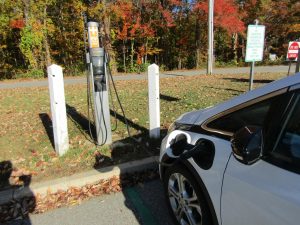Society is always trying to improve and advance our technology and cars are no exception. From the start in 1886 with Carl Benz making the first gasoline powered car and fast-forwarding to now where we have cars that can drive themselves and electric cars, things have indeed changed.
But which is better, gas or electric? We made the electric car in hopes to create a more sustainable and more environmentally friendly alternative for cars, but did we succeed?
Well to determine that you have to look at how EV batteries are made. They are made from: Lithium, Cobalt, Manganese, Nickel, Graphite Typically, these minerals are extracted from mines found all over the world, with large deposits found in areas like Africa, South America, and Australia. Some of these minerals can also be gathered by recycling previously manufactured EV batteries, though this process is currently less mature than the extraction process. The extracted minerals are sent to processing plants and refineries, which convert them into anode and cathode electrodes in galvanic cells. Many midstream companies are based in Asia.
Then you also have to consider how is gas made. Gasoline is made by breaking down crude oil into petroleum products through fractional distillation to create usable gasoline. So it takes less effort to make gasoline and other petroleum products, but it takes much more time to extract crude oil than it does to mine the minerals for a battery.
You also have to look at how much both style emit negative materials.
How much do gas powered cars emit? CO2 emissions from a gallon of gasoline are 8,887 grams CO2 per gallon. CO2 emissions from a gallon of diesel: 10,180 grams CO2 per gallon. The average passenger vehicle emits about 400 grams of CO2 per mile. A typical passenger vehicle emits about 4.6 metric tons of CO2 per year. and gas powered cars don’t only emit CO2.
In addition to carbon dioxide (CO2), automobiles using gasoline produce methane and nitrous oxide (N2O) from the tailpipe and all vehicles can emit hydro fluorocarbon from leaking air conditioners. For gasoline vehicles, the emissions of HFCs are small in comparison to CO2.
And most people think that electric cars don’t emit anything but that is incorrect. Electric vehicles also emit a small amount of GHGs due to air conditioner/HFC leakage. Now, this is much less than gas powered cars, but it still counts.
For a full understanding of which is better you also need to see which has a better lifespan / longevity, Gasoline and most petroleum products can’t be recycled, whereas EV batteries can be recycled? The high recovery rates: 90-99% nickel, cobalt, lithium low environmental impact ideal for batteries containing nickel and cobalt.
You also need to see how these products are broken down. Gas is not disposed because its burnt off in your vehicle, while EV batteries are sent them to specialist firms that dismantle the packs and break them down into their different materials: wires, circuitry, plastics, the actual cells. The cells and circuits are crushed to separate and purify the various metals in them, including nickel and lithium.
When considering which car alternative is better there are two more things that matter: safety and reliability. When it comes to safety in electric cars, if you get into a crash there is a higher fatality rate from electric cars and there were 1.4 million fires that caused damage, injury, or death in the United States in 2020. There were 3,500 fire-related deaths and 15,200 fire-related injuries from these fires. Vehicle fires accounted for 15% of those fires, 18% of civilian deaths, and 11% of civilian injuries. That’s 210,000 fires, 630 deaths, and 1,672 injuries.
As part of the fire data, vehicle fires in garages were not considered structure fires if the structure itself didn’t burn. Vehicle fires also accounted for more than $5 billion in damages. but also how lethal electric car fires are. Fighting fires is about two things: cooling the burning surfaces and starving the fire itself of oxygen. Water is the most effective coolant. It’s also the most environmentally safe, and in most cases, it’s the most accessible, too.
Water is not great at reducing the oxygen that feeds the fire. Removing the oxygen from the air is impossible, but it is possible to cover the burning material with something so that oxygen cannot keep it going. Some of these oxygen deprivation materials include ABC ultra-fine powder, BC ultra-fine powder, and Novec 1230. Each of these items affects the thermal runaway, accompanying fire, and toxic gas production differently. Many firefighters use them in combination with water as the cooling agent, as recommended by the National Transportation Safety Board.
Prevention is the best cure for electric vehicle fires. Proper and regular maintenance and problem attentiveness are two great ways to prevent such fires from happening in the first place. Fortunately, these events are rare, even among the vehicles that often catch fire. With gas powered cars, Auto Insurance EZ compiled sales and accident data from the Bureau of Transportation Statistics and the National Transportation Safety Board. The site found that hybrid vehicles had the most fires per 100,000 sales at 3474.5. There were 1529.9 fires per 100k for gas vehicles and just 25.1 fires per 100 thousand sales for electric vehicles.
Let us sanity-check the numbers. Average cars last for about 12 years. There are about 6 million car accidents in an average year in the USA. There are about 180,000-220,000 car accidents that involve a fire each year. 3% of the car accidents have a fire. This would suggest that 2.4-3.0 million car fire accidents for the 12-year-life of 250 million car cohort (2008-2020). This would be 0.9-1.2% of gasoline or diesel cars will have a fire accident over the life of the vehicle. There would be 72 million car accidents of any kind over the 12-year-life of 250 million car cohort. Around 29% of the cars get into some kind of car accident. The actual total would be less at around 20-25% as some cars would be in multiple accidents. Simply put, the odds of this happening to you are tiny.
Now that we know how both types of cars can affect each other and the earth, most people are more worried about which alternative is cheaper for them so let’s look at how much does it cost to make an electric car. The battery-powered version of G.M.’s Equinox Crossover, for example, starts around $30,000 when it arrives this fall, the carmaker has said. That is $3,400 more than the least expensive gasoline-fueled Equinox. But factoring in government incentives, the electric Equinox should be cheaper. Like all electric vehicles, the car will need less maintenance, and the electricity to power it will cost less than the gasoline used by its combustion engine equivalent.

While when people are looking at whether to get an electric car or gas powered car they look at how far they go and how much it costs to refill them. So let’s look at how far can the average gas powered car go go on a full tank of gas. You can determine how far you can drive on a full tank of fuel by multiplying the miles per gallon rating on a new vehicle by the number of gallons you can fill in a tank. For instance, for Equinox Crossover, the rated MPG in city driving is 23, and the tank holds 25 gallons. This means you could drive around 575 miles on a single tank of fuel. Your results will vary, depending on driving conditions, how fast you drive, and the condition of your engine.
Not only do you need to see how far the cars can go you need to see how much it costs to refill them so How much does it cost to fill the average gas tank? The amount of gas a car holds depends on the vehicle’s size. Smaller cars generally have gas tanks that hold 12 gallons, while larger cars can hold 15 or 16 gallons. Let’s say gas in your area costs $3.85 a gallon; that means a car with a 12-gallon tank costs $46.20 to fill up, while a larger car with a 15-gallon tank costs $57.75.
But, how far can the average electric car go on a full charge? All-electric vehicles, also referred to as battery electric vehicles (BEVs), run entirely on an electric charge from a rechargeable battery, with no other fuel source needed. Average driving range is 250 – 500 miles. How much does it cost to charge the average electric car? Suppose you drive about 1,207 miles per month (Americans go an average of about 14,489 miles annually). For an EV, you will use about 402 kWh in that time frame. Using the U.S. household average of 16.88 cents per kWh, charging an electric car at home would cost nearly $68 per month.
So now that we have looked at how much cars affect the environment, how economical they are, and with the rise in electric cars and the attempt to “go green” and to lower the consumption of petrol products, which way do you lean?








































